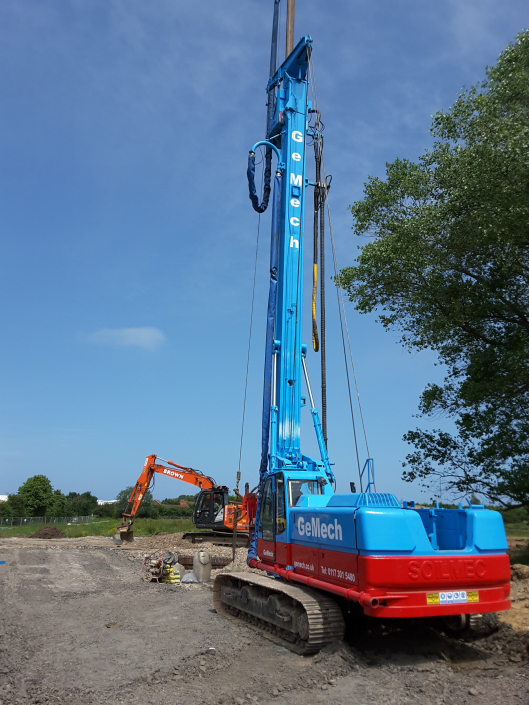Continuous flight auger piling, also known as CFA piling, is an effective and versatile piling solution, suitable for a wide range of ground conditions and soil types including:
- Sand
- Gravel
- Weaker rock
- Silts
- Clay
Because of its versatility and effectiveness, CFA piles have become one of the most popular methods of piling used in the UK today.
CFA piling methods are also adopted for a range or piled embedded wall solutions, such as king post walls, contiguous piled walls, and secant piled retaining walls.
Contact our expert piling team/engineers for advice on your project and get a no obligation quote
What We Offer
- Free site visits
- Free no obligation quotes
- 12 Year warranty of all work
- Estimates based on detailed tender stage designs
The CFA Piling Process
The process of forming CFA piles is completed in one continuous operation, using instrumented piling rigs to monitor the pile construction process in real time as the auger is progressed to depth, and whilst concrete is being placed.
The CFA piling method is fast and efficient, generating low levels of noise, and is virtually vibration free.
Step 1 – Prior to the rig arriving to site the client surveys the area for services, prepares a suitable working platform at top of foundation level, and drives a numbered pin into the working platform at each pile position.
Step 2 – A health and safety briefing will take place, the rig will be prepared to work, and moved to the first pile position.
Step 3 – The auger is positioned over the setting out point and zeroed at working platform level. The auger is then progressed to a predetermined designed depth, pausing occasionally to bring spoil to the surface.
Step 4 – Readymix concrete will be delivered to site and pumped to the rig using a system of hoses connected to the top of the auger. The rig operator begins extracting the auger string, ensuring a constant head of concrete is maintained within the auger to avoid the risk of borehole collapse during construction. This process is fully computerised in CFA rigs, providing the rig operator a continuous profile of pile diameter during auger extraction.
Step 5 – The attendant excavator clears spoil from piling mat level, exposing the fresh concrete at the head of the pile.
Step 6 – A reinforcement cage, meeting the design requirements, is plunged into the fresh concrete, to provide fixity between the piles and reinforced concrete foundations.

When are CFA Piles used?
CFA piling is widely used on projects ranging from residential housing, commercial development & refurbishment, to large scale civil engineering projects, and many more.
They are equally suited to piled raft slab and traditional ground beam and pile cap applications.
In addition to the construction of bearing piles, CFA piling methods are equally well suited to the construction of contiguous, secant and king post embedded piled retaining walls.
Using CFA rigs , equipped with pull down/crowd function and rock augers, like the ones within our fleet, it is possible to install CFA piles through Weak Rock formations, avoiding having to revert to more expensive percussive drilling or rotary bored piling methods.
To get a better understanding of when CFA piling is used, check out our case studies pages.

Our Piling Rigs
Our rigs are equipped with on-board instrumentation systems to ensure high quality pile construction and record keeping.
Our current augered piling fleet consists of:
CFA
- Comacchio CH 450
- Soilmec SR30
- Soilmec R312
- Geax EK110
- Geax EK75
SFA
- Hutte HBR204
- Hutte HBR203
You can find out more about our rig collection on our fleet page.
FAQ’s
Q – What equipment is needed for cfa piles?
A – CFA piles are installed using specialist drilling rigs. The drilling rigs in GeMech’s owned fleet range from 5.0t up to a maximum of 50.0t. The CFA drilling rig will be supplement on site by a trailer mounted concrete pump, a concrete agitator drum, and an attending excavator. The attending excavator is typically provided by the Client, but can be provided by GeMech when necessary.
Q – How many cfa piles can be done per day?
A – Daily production rates are dependant on a number of factors, including but not limited to, rig size, pile diameter, pile depth, ground conditions, material availability, and site logistics.
For our larger rigs > 25.0t, we would typically expect to install between 10 & 35 piles per day, whereas using our < 25.0t rigs we might expect to install anywhere between 5 & 20 piles per day.
Capabilities:
- Pile diameter 300mm – 900mm
- Maximum depth 25.0m
- Working loads up to 3,300kN
ready to get started?











Quick Links
Help & Legal

Bristol office
Unit 12 Kenn Court,
South Bristol Business Park,
Roman Farm Rd,
Bristol BS4 1UL,
United Kingdom
Tel: 01173015480
E-mail: info@gemechltd.co.uk
Watford office
Metro Centre,
28 Dwight Rd, Northwood,
Watford WD18 9SB,
United Kingdom
E-mail: info@gemechltd.co.uk












